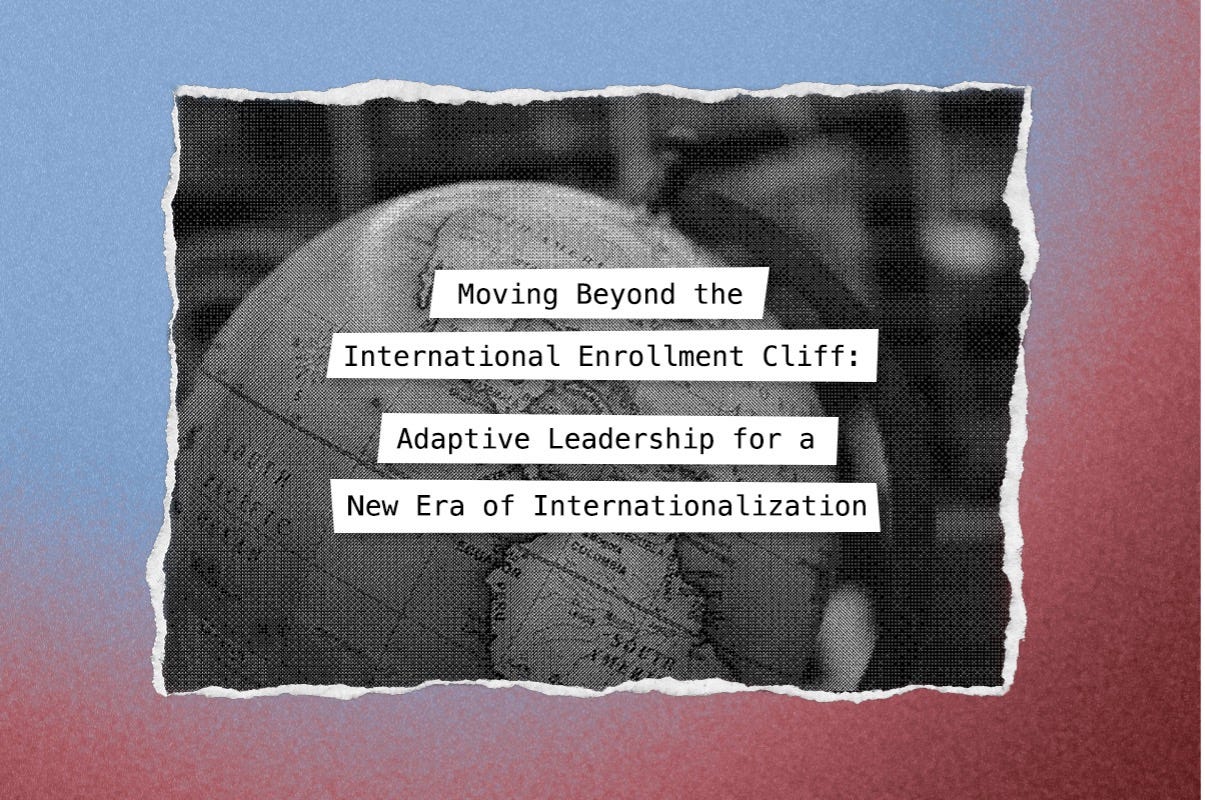Moving Beyond the International Enrollment Cliff (Part Two):
Adaptive Leadership for a New Era of Internationalization
This is the second post in a two-part series from guest contributor Joshua Travis Brown. author of the new book, Capitalizing on College (Oxford University Press).
You can read his first post in this series, “How American Universities Built Their Own International Enrollment Cliff”, as well as watch my video interview with him.
Introduction
“They’re what I call the schools of yesterday,” the president told me in describing his university’s competition, “because they look like the state of yesterday.”
His confidence wasn't misplaced. Walking through his campus, Spanish conversations mixed with Mandarin, and traditional dress from other countries intermingled with university hoodies. Looking at his institution's demographics, the contrast with traditional universities was stark:
They have less than 20% minorities. We’re 50% Hispanic, almost 20% international, 6% African American, 2% American Indian. We’re a school of today and tomorrow. Their markets are shrinking, my market is growing. They may have a big dollar endowment, but they don’t have a future. I got a future.
As I detailed in Part One of this series, American universities had quietly transformed international programs from cultural exchange into financial lifelines, but in doing so also created dependencies that became vulnerabilities when geopolitical tensions threatened revenue streams.
Today, those vulnerabilities are being exposed in ways and at a scale few anticipated.
When I conducted these interviews, the optimism and momentum around internationalization were palpable. However, the landscape has dramatically shifted since then.
NAFSA is predicting a 30-40% drop in new student enrollments (potentially 150,000 students) due to severe visa backlogs, and the elimination of ‘duration of status’ for student visas in favor of fixed-term stays make extensions more unpredictable, complicated, and costly. The elimination of OPT (Optional Practical Training), which the majority of international students take advantage of, will also affect over 200,000 students.
Through my research for Capitalizing on College, three distinct patterns emerged in institutional strategies for internationalization. What follows is not just a summary of those approaches, but an exploration of how the most effective leaders are navigating the discomfort, ambiguity, and promise embedded in this era of unprecedented change.
The Future is Here – Adapt Now
Boston College professor Chris Glass argues that today’s complex geopolitical landscape demands more than incremental tweaks; it calls for a profound shift in mindset:
We are at a critical moment in higher education that demands adaptive leadership… we’ve entered a fundamentally different era of internationalization.
The most successful institutions I studied embraced this new reality. Rather than simply reacting, one senior administrator described how they were redesigning the student experience with flexibility and mobility at the center:
Students can start a degree here and end up in Houston and finish it there. That is starting for Chinese students… we have an alpha group here right now. You are going to find a lot of us partnering with institutions we never would have partnered with before where we recognize faculty, programs, credits, joint list our courses so you can take a course here and next week you can be in New York and take another course. It is going to be a dramatic change.
A professor at another school explained how graduate and certificate programs were tailored to workforce needs and student demand:
We are recruiting in new ways… We are doing more in terms of developing academic programs in the graduate market and in the non-degree, certificate-based market… Because that [is] what people are looking for…
From these conversations, three guiding principles emerged: a holistic student lifecycle approach, disciplined strategic focus, and the cultivation of sustainable systems.
A Student Lifecycle Approach
“You know the diversity of the growth brought huge challenges,” admitted one professor, reflecting on her institution's rapid international expansion. What she had discovered was a truth that many universities learn the hard way: recruitment without genuine support is a recipe for attrition and disappointment—for students and institutions alike.
The limitations of the financial logic—simply increasing international enrollment for short-term revenue gains—are now unmistakable. As the American Council on Education (ACE) emphasizes, real institutional sustainability requires the integration of policies, programs, and values across the student lifecycle: before arrival, during campus life, and after graduation. One provost in Capitalizing on College put it bluntly:
You have got to have all the safety nets, bridge programs, student support services to be able to support these students from a retention standpoint.
This is not a peripheral concern, but the foundation of a new compact for international students. In the new era, universities must deliberately cultivate both “soft belonging”—the relational, cultural, and emotional bonds that enable students to thrive—and “hard belonging”—the structural, legal, and economic frameworks that determine who has access, voice, and agency.
As I argue in my empirical research, college and university leaders must offer student support for seen (residential) and unseen (online) students alike. Equality in the modern era of higher education must span modalities, particularly in international programs. Schools that master this holistic approach to student support are best positioned to achieve long-term success.
Strategic Focus
Another principle guiding institutions was a focused international strategy. Rather than spreading resources thinly across many opportunities, some universities chose to concentrate their efforts and expertise on specific countries or regions. As one university president noted, “There is no university in the world that can be good at every country,” highlighting the strategic necessity of avoiding international overreach. His institution opted for a methodical, targeted approach:
I wanted us to focus on a single country, to get extremely good at it so we become the portal to that country, and move from this country to that country… The country I picked was China, and it has just blossomed for us… We have 1,000 graduates from our programs just in China, a huge network of Chinese students coming to this university, and many, many, many of our students going to China on Chinese government scholarships.
The chancellor at another institution that initially took a similar approach noted the end result of this strategy: “We have a lot of students in East Asia,” he observed, while wryly adding, “The president likes to say, ‘You cannot throw a stick in East Asia without running into our graduates.”
Such focused international strategies can provide powerful, compounded advantages for higher education institutions. By concentrating on particular countries or regions, universities were able to develop deeper government partnerships, nurture robust alumni networks, cultivate faculty expertise attuned to local realities, and often unlock opportunities to expand programs or establish new campuses.
In a perspective that now seems prescient, one university executive told me, “Where there’s change there’s danger, and where there’s change there’s opportunity.”
In retrospect, these words capture the essential tension faced by institutions today. A focused international strategy can be a source of genuine competitive advantage—deep local ties and specialized expertise often secure an institution’s future. Yet at the same time, such focus can magnify vulnerability to external shocks. The very focus some leaders hailed as a marker of success also reveals the danger of overexposure—especially as Chinese student enrollment has dropped by more than 100,000 students (-25%) in the last five years.
Strategic focus is powerful when paired with vigilance and adaptability, turning intention into advantage, while never losing sight that where there’s “opportunity,” there is also “danger.”
Sustainable Systems
It is no secret that American higher education is rife with inefficiencies. As I have covered in previous issues of The Leading Edge, schools of tomorrow must find a way to minimize institutional inefficiency and develop the agility necessary to adapt to today’s shifting educational landscape.
Among the most promising—but also most challenging—innovations are scalable and replicable systems: modular, standardized frameworks engineered to support rapid growth, including international expansion. On the surface, these systems are a compelling answer to market pressures, enabling institutions to enter new environments with unprecedented speed and flexibility. As one faculty member put it:
It really takes us just two weeks to set up a system to get ready to offer a bachelor’s degree in [lists countries]. We have the structure for it… Other than the physical infrastructure, we just need two weeks to set up our system over there with the instructors and the curriculum...we have the infrastructure from here to just go mobile.
The speed of such expansion is often enabled by streamlined, top-down governance. One provost emphasized:
It’s pretty entrepreneurial and innovative. We don’t discuss things to death. You go through your processes in 60-90 days and ‘Boom!’ make a decision.
A vice president overseeing international market exploration echoed this need for agility:
We can move really quick and that gives you the ability to create initiatives that in the long term are going to bring you students. The model works really well because it is not bureaucratic and it is not long.
While agile decision-making can accelerate change, it risks sidelining the vital perspectives and expertise of faculty, staff, students, and local partners. To remain truly trusted, replicable systems demand leadership at every level— inviting continuous reassessment, innovation, and buy-in from across the institution and beyond.
Sustainable international programs and partnerships demand more than efficient frameworks; they depend on governance that actively builds legitimacy, deepens trust, and stays closely attuned to new realities. In this new era, adaptive leadership combines agility with a commitment to shared responsibility, inviting all stakeholders to collaborate rather than defaulting to one-sided strategies driven solely by institutional survival.
Conclusion
As Chris Glass argues in “Four Eras of International Student Mobility (1945-2025)” we have entered a fundamentally different era of internationalization in which old norms no longer hold. He put it even more plainly in “The End of Belonging”: Where once students were “given a space” through state-sponsored exchanges or could “buy a space” as part of a market, today, in what Glass calls Cold War 2.0, “you must secure a space” due to strategic statecraft.
He cautions:
Enrollment declines won’t be solved by better marketing; they’re a signal of deeper geopolitical shifts requiring fundamental institutional adaptation.
The profound shocks of new legislation and shifting policy demand that colleges and universities move beyond questions of speed and growth to consider more deliberately for whom and to what purpose they adapt. Today’s realities—falling international enrollments, escalating affordability challenges, and new regulatory changes—require institutions to fundamentally rethink their internationalization strategies.
In this environment, the most resilient institutions are defined not only by unwavering commitment to holistic student support, disciplined strategic focus, and adaptability as a core value, but also by their capacity for adaptive leadership.
At the heart of adaptive leadership lies the continuous work of trust-building—within campus communities, across institutional boundaries, and with international partners and students. It calls on leaders to help their communities acknowledge and mourn what is ending, while clarifying what is essential and enduring, and what must be allowed to adapt or be left behind.
Adaptability springs from a deep reserve of trust—filled and renewed by leaders who work collectively, maintain perspective, and foster collaboration to navigate the unpredictable and uncertain future of international education. This is the work that sustains institutions and enables them not only to endure disruption, but to lead with purpose in a new era of internationalization.






